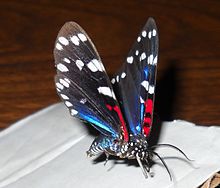| Composia fidelissima | |
|---|---|

| |
|
Scientific classification
| |
| Domain: | Eukaryota |
| Kingdom: | Animalia |
| Phylum: | Arthropoda |
| Class: | Insecta |
| Order: | Lepidoptera |
| Superfamily: | Noctuoidea |
| Family: | Erebidae |
| Subfamily: | Arctiinae |
| Genus: | Composia |
| Species: | C. fidelissima
|
| Binomial name | |
| Composia fidelissima
Herrich-Schäffer, 1866
| |
| Synonyms | |
| |
Composia fidelissima the faithful beauty or Uncle Sam moth is a moth in the family Erebidae. It is found in southern Florida and the West Indies, including Cuba. The species was first described by Gottlieb August Wilhelm Herrich-Schäffer in 1866. [1]
The wingspan is 48–64 mm. Adults are on wing year round. They are day flying. [2]
The larvae feed on Cynanchum scoparium, Canavalia (including Canavalia rosea), Nerium (including Nerium oleander) and Echites species (including Echites umbellatus).
Subspecies
- Composia fidelissima fidelissima
- Composia fidelissima vagrans Bates, 1933
References
- ^ Becker, Vitor O. (2002). "The Noctuoidea (Lepidoptera) from Cuba described by Herrich-Schäffer and Gundlach in the Gundlach Collection, Havana" (PDF). Revista Brasileira de Zoologia. 19 (2): 349–391. doi: 10.1590/S0101-81752002000200006. Archived from the original (PDF) on April 29, 2013. Retrieved March 8, 2012.
- ^ Cotinis (November 30, 2016). "Species Composia fidelissima - Faithful Beauty - Hodges#8038". BugGuide. Retrieved December 2, 2018.
| Composia fidelissima | |
|---|---|

| |
|
Scientific classification
| |
| Domain: | Eukaryota |
| Kingdom: | Animalia |
| Phylum: | Arthropoda |
| Class: | Insecta |
| Order: | Lepidoptera |
| Superfamily: | Noctuoidea |
| Family: | Erebidae |
| Subfamily: | Arctiinae |
| Genus: | Composia |
| Species: | C. fidelissima
|
| Binomial name | |
| Composia fidelissima
Herrich-Schäffer, 1866
| |
| Synonyms | |
| |
Composia fidelissima the faithful beauty or Uncle Sam moth is a moth in the family Erebidae. It is found in southern Florida and the West Indies, including Cuba. The species was first described by Gottlieb August Wilhelm Herrich-Schäffer in 1866. [1]
The wingspan is 48–64 mm. Adults are on wing year round. They are day flying. [2]
The larvae feed on Cynanchum scoparium, Canavalia (including Canavalia rosea), Nerium (including Nerium oleander) and Echites species (including Echites umbellatus).
Subspecies
- Composia fidelissima fidelissima
- Composia fidelissima vagrans Bates, 1933
References
- ^ Becker, Vitor O. (2002). "The Noctuoidea (Lepidoptera) from Cuba described by Herrich-Schäffer and Gundlach in the Gundlach Collection, Havana" (PDF). Revista Brasileira de Zoologia. 19 (2): 349–391. doi: 10.1590/S0101-81752002000200006. Archived from the original (PDF) on April 29, 2013. Retrieved March 8, 2012.
- ^ Cotinis (November 30, 2016). "Species Composia fidelissima - Faithful Beauty - Hodges#8038". BugGuide. Retrieved December 2, 2018.